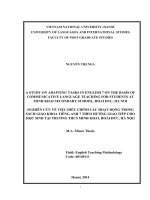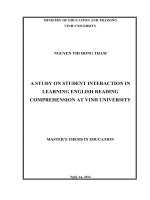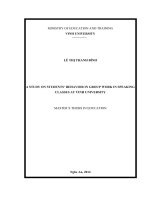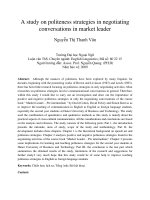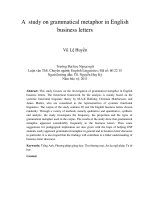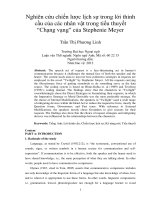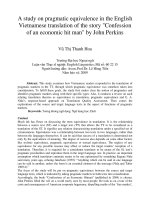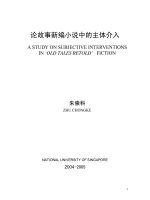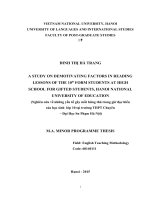A study on adjacency pairs in political interviews with the u s president joe biden
Bạn đang xem bản rút gọn của tài liệu. Xem và tải ngay bản đầy đủ của tài liệu tại đây (1.92 MB, 166 trang )
MINISTRY OF EDUCATION AND TRAINING
QUY NHON UNIVERSITY
THAI THI NGUYEN TRANG
A STUDY ON ADJACENCY PAIRS IN POLITICAL
INTERVIEWS WITH THE U.S PRESIDENT
JOE BIDEN
Field: English Linguistics
Code: 8220201
Supervisor: BUI THI DAO, Ph.D
BỘ GIÁO DỤC VÀ ĐÀO TẠO
TRƯỜNG ĐẠI HỌC QUY NHƠN
THÁI THỊ NGUYÊN TRANG
NGHIÊN CỨU VỀ CẶP KẾ CẬN TRONG CÁC CUỘC
PHỎNG VẤN CHÍNH TRỊ VỚI TỔNG THỐNG HOA KỲ
JOE BIDEN
Ngành: Ngôn ngữ Anh
Mã số: 8220201
Người hướng dẫn: TS. BÙI THỊ ĐÀO
i
STATEMENT OF AUTHORSHIP
I totally assure that thesis ―A Study on Adjacency Pairs in Political
Interviews with the U.S President Joe Biden‖ is my own work for the purpose
of graduating the MA course of English Linguistics.
The content of this thesis has not been published or written by any other
authors except for some references which are used in this thesis.
Thesis has not been submitted for any degree or diploma in any
university.
Binh Dinh, November, 2023
Thái Thị Nguyên Trang
ii
ACKNOWLEDGEMENTS
The total completion of this scientific research project is the result of not
only my efforts but also the precious assistance of those to whom I would like
to express my sincere gratitude.
First of all, I would like to express the most special appreciation and the
deepest thanks to my supervisor, Dr. Bui Thi Dao, for her useful advice,
aspiring guidance, invaluably constructive criticisms, and especially for her
endless patience and warm encouragement during my whole study.
Secondly, my deep indebtedness comes to Quy Nhon University, the
Department of Foreign Languages and the Post-Graduate Training Office for
permitting me to conduct this research.
Thirdly, I am extremely thankful to all lecturers of the Master Course of
English Linguistics K24B who were dedicated to teaching me useful
knowledge about linguistics, pragmatics, sociolinguistics, psycholinguistics,
etc. as well as instructing me on how to write well a scientific research or an
academic writing in order that I can have a source of inspiration to proudly
complete my research project.
Last but not least, I owe an unpaid debt to all the generous support, love,
and care from my beloved families and friends, which has given me more
strength, belief, and motivation to overcome all troubles in the whole process
of this research.
v
ABSTRACT
This is a study of adjacency pairs in conversations extracted from
political interviews between international journalists and the U.S President
Joe Biden during the period of 2020-2023. The study aims to examine the
types and frequencies of adjacency pairs and to explore preferred and
dispreferred responses in the second pair parts of adjacency pairs, sequence
types and verbal strategies for doing dispreferred responses in the investigated
data. Descriptive method is conducted as the main method in the combination
of both qualitative and quantitative approaches in this study.
Based on the analysis of the data, the results of the research show types
of adjacency pairs in which the highest type is Question – Answer, while the
lowest occurrence belongs to Threat – Counter Threat type. The research
further indicates preferred responses and dispreferred responses in the second
parts of adjacency pairs. Moreover, sequences types including insertion
sequences and post-sequences are also found to be embedded in the second
part of adjacency pairs. Lastly, all verbal strategies for doing dispreferred
second parts are found in the examined data of dispreferred adjacency pairs.
Those are delaying, using preface, expressing doubt, using token Yes,
apologizing, mentioning obligation, appealing for understanding, making it
non-personal, giving an account, using mitigators and hedging the negative.
The study results are also expected to help English language learners and
other scholarship researchers understand clearly about adjacency pairs to
communicate and interact speaking effectively.
Keywords: adjacency pairs, preferred responses, dispreferred responses,
sequence types, verbal strategies.
vi
TABLE OF CONTENT
STATEMENT OF AUTHORSHIP ................................................................... i
ACKNOWLEDGEMENTS .............................................................................. ii
ABSTRACT ...................................................................................................... v
TABLE OF CONTENT ................................................................................... vi
ABBREVIATIONS........................................................................................ viii
LIST OF TABLES ........................................................................................... ix
LIST OF FIGURES........................................................................................... x
CHAPTER 1. INTRODUCTION .................................................................. 1
1.1. Rationale ................................................................................................ 1
1.2. Aim and objectives................................................................................. 4
1.2.1. Aim...................................................................................................... 4
1.2.2. Objectives............................................................................................ 4
1.3. Research questions ................................................................................. 5
1.4. Scope of the study .................................................................................. 5
1.5. Significance of the study........................................................................ 6
1.6. Organization of the study ....................................................................... 7
CHAPTER 2. LITERATURE REVIEW ...................................................... 8
2.1. Conversation .......................................................................................... 8
2.2. Conversation Analysis ........................................................................... 9
2.3. Political Interview ................................................................................ 10
2.4. Adjacency Pairs.................................................................................... 11
2.4.1 Definitions of Adjacency Pairs .......................................................... 11
2.4.2. Types of Adjacency Pairs ................................................................. 13
2.4.3. Ways of recognizing Adjacency Pairs through responses in the
second pair parts.......................................................................................... 17
2.5. Previous Related Studies...................................................................... 27
2.6. Biography of the U.S President Joe Biden and political interviews with
him............................................................................................................... 31
2.7. Summary .............................................................................................. 32
vii
CHAPTER 3. RESEARCH METHODOLOGY........................................ 34
3.1. Research design.................................................................................... 34
3.2. Research methods................................................................................. 34
3.3. Data Collection..................................................................................... 36
3.4. Research Procedures ............................................................................ 36
3.5. Validity and Reliability ........................................................................ 37
CHAPTER 4. FINDINGS AND DISCUSSION ......................................... 39
4.1. Types and frequencies of adjacency pairs in the investigated data ..... 39
4.2. Characteristics of recognizing adjacency pairs in the investigated data57
4.3. Discussions........................................................................................... 70
4.4. Summary .............................................................................................. 72
CHAPTER 5. CONCLUSION AND IMPLICATIONS ............................ 75
5.1. Conclusions of the study ...................................................................... 75
5.2. Implications of the study...................................................................... 77
5.3. Limitations of the study ....................................................................... 77
5.4. Suggestions for future studies .............................................................. 78
REFERENCE ................................................................................................ 79
APPENDICES
AP viii
The A.P
CA ABBREVIATIONS
[A-A]
[A-Ac] Adjacency Pairs
[B-D] The Associated Press of America
[C-A] Conversation Analysis
[Co-R] Assessment - Agreement
[G-G] Announcement - Acknowledgement
[L-L] Blame - Denial
[Q-A] Compliment - Acceptance
[R-A] Complaint - Response
[S-A] Greeting - Greeting
[T-Ct] Leave taking – Leave taking response
[W-Ac] Question - Answer
U.S Request - Agreement
Summons - Answer
Threat – Counter Threat
Warning - Acknowledgement
The United States of America
ix
LIST OF TABLES
Table 2.1. Types of Adjacency pairs proposed by Paltridge (2000: 91-99) ... 17
Table 2.2. Common Adjacency Pairs and typical preferred and dispreferred
second pair parts (Levinson, 1983)............................................... 19
Table 4.1. Types and Frequencies of Adjacency Pairs in political interviews
with the U.S President Joe Biden ................................................. 40
Table 4.2. Distribution of preference organization in the second pair parts... 57
Table 4.3. Type of sequences embedded within the adjacency pairs ............. 61
Table 4.4. Verbal strategies for doing a dispreferred second part in
conversations................................................................................. 63
x
LIST OF FIGURES
Figure 2.1. Preference organization in adjacency pairs by Yule (1997) ........ 18
Figure 4.1. The dominant types of Adjacency Pairs ....................................... 41
Figure 4.2. The rate of preferred and dispreferred responses in the second
parts of adjacency pairs................................................................. 59
1
CHAPTER 1
INTRODUCTION
This chapter aims to set the context for this study. The chapter is
organized into six sections. It begins with presenting the reason for
conducting a study on adjacency pairs in political interviews with the
President U.S Joe Biden. The research aim, objectives and the research
questions are followed. Finally, it outlines the structure of this thesis.
1.1. Rationale
Language has been considered a medium to communicate with each
other in social life and the most important means of communication in social
interaction. Related to that, language has the most important role in all aspects
of life. People use language to communicate with each other through
meanings produced by both speakers in conversations (Tarigan, 2016). It can
be said that communication activities might involve good coordination
between speakers and listeners in order for the conversation to go well. It
means that the speaker should convey the message clearly so that the listener
can understand what the speaker means, and then when the message has been
transferred and can be understood by the two speakers, For this reason, there
is a correlation in the conversation (Sacks and Schegloff, 2000).
In a discussion, the speaker's and the hearer's tasks are both obviously
autonomous, meaning that each of them is aware of what to say and how to
react depending on the previous utterance of the speaker. The practice of
allowing each speaker and listener to speak and listen in turn during a
conversation is known as turn-taking (Garcia, 1991). However, both the
speakers and the listeners find dialogue challenging. The reason for this is that
communication is a challenging process in which the speakers and the hearers
share roles. As both the speaker and the hearer suggest comparable or
2
dissimilar speech acts during conversation, each role might be mutually
opposed. For instance, if a speaker asks a question, the hearer should then
respond. However, if the hearer asks the speaker a different question, the
expected response may be different. As a result, it has become common
knowledge that each speaker has a response in mind that the first speaker
either expects or does not expect. (Coates, 2004; Orestrom, 1983).
According to Sacks and Schegloff (2000), the fundamental structural
factor in conversation analysis is called the adjacency pair. Adjacency pair
has been considered one of the most important studies in language
communication because it is a basic way to organize conversations. As
Partridge (2006:107) described, ―conversation is the main way in which
people come together, exchange information, negotiate, and maintain social
relations.‖ According to Partridge, conversational interaction is an activity of
people‘s senses where two or more people talk to transfer an idea or
information from a speaker to a listener to build social interaction.
Adjacency Pairs are also defined by Coulthard (1985:70) as constructive
exchanges in a conversation that aid in identifying the first speaker, whose
responsibility it is to initiate a discussion, and the second speaker, who acts as
the hearer and responds to the first speaker's initiated act. Adjacency Pairs
also assist in maintaining the speakers‘ and learners‘ roles and prevent them
from abusing their turn as the discourse progresses. Adjacency Pairs are
systematically formed in two utterances by the speakers and the hearers,
according to Yule (1996:77), who supports this.
Thus, this research has been done in order to find out more information
about conversation analysis through adjacency pairs, in which an utterance
made by one speaker is responded to by another utterance from another
speaker. As Sacks and Schegloff (2000) stated, an adjacency pair, which is
the most important part of conversational structure, is composed of two
3
utterances by two speakers, one after the other (as cited in Coulthard, 1985).
The speaking of the first utterance (the first pair part) conveys a responding
utterance (the second pair part). Adjacency pairs exist in every language and
vary in context and content based on the cultural values held by speakers.
Sacks and Schegloff (2000) further explain that in conversational
communication, adjacency pairs also explore the politeness and willingness of
one speaker to deal with the feelings of the second speaker, as exhibited in
conventional greetings, invitations, and requests.
Jack and Schmidt (1983) also note that since the goal of language
teaching is to enable learners to use language in ways that are
communicatively effective and appropriate; the research of communicative
language has taken on an increasingly important role in recent years.
However, a common interest emerges in how language reflects the utterance it
performs, as well as the processes involved in using adjacency pairs for
communication. The adjacency pair is considered one of the most effective
forms of communication and plays a key role in social interaction. Sacks and
Schegloff (2000).
Vietnamese linguists identify adjacency pairs as ―cặp kế cận‖ (Diệp
Quang Ban, Đỗ Hữu Châu) or ―cặp thoại‖ (Nguyễn Đức Dân, Nguyễn Thiện
Giáp) based on different points of understanding to create the diversity in
theoretical scope of conversational analysis research.
Đỗ Hữu Châu (2001) clarifies that discourse is the result of speech acts
in which all speech acts need a response compatible with an introduction act,
forming pairs such as asking/answering, greeting/greeting,
thanking/responding, or requesting/replying to be called adjacency pairs.
Similarly, Diệp Quang Ban (2009) defines an adjacency pair as a sequence of
utterances made by different speakers. It is considered one of the central
concepts of conversational analysis research, which shows the integration of
4
the mechanism of turn-taking and the choice of the next person creating the
next turn in a sequence of actions.
In his different theoretical approach, Nguyễn Đức Dân (1998) states that
the two turns of a speech are intimately connected and stand next to each
other to create an adjacency pair. Nguyễn Thiện Giáp (2000) also agrees that
adjacency pairs are two utterances that are directly related to each other.
Despite certain variations, an adjacency pair is a key unit of the
discourse structure. It is the smallest unit that reflects the speaker's and
listener's interactions.
For all the above reasons, this study is thus focused on adjacency pairs in
political interviews, in order not only to help English learners improve their
English communication skills but also to help other people who are interested
in the political aspects understand the meanings of the political dialogues or
strategies of national leaders. These interviews are so new that there has been
no study on adjacency pairs regarding ―political interviews with President Joe
Biden." That‘s the reason why the research title “A study on adjacency pairs
in political interviews with the U.S President Joe Biden” has been chosen
first to help learners achieve their communicative goals and avoid
misunderstanding, and then, to some extent, to give some practical values in
language teaching.
1.2. Aim and objectives
1.2.1. Aim
The study aims to examine adjacency pairs that occurred in political
interviews with the U.S President Joe Biden.
1.2.2. Objectives
The following detailed objectives are set to ensure the implementation of
the above aim:
5
To examine the types and frequencies of adjacency pairs in political
interviews with the U.S President Joe Biden.
To recognize adjacency pairs through responses of the second pair
parts, i.e., preferred and dispreferred, and verbal strategies in conversations of
political interviews with the U.S President Joe Biden.
1.3. Research questions
This thesis focuses on answering the two main questions that can clarify
the objectives:
1. What are the types and frequencies of adjacency pairs used in the
political interviews with the U.S President Joe Biden?
2. What are the characteristics of recognizing adjacency pairs in
conversations about political interviews with the U.S President Joe Biden?
1.4. Scope of the study
This study is focused on a descriptive account of the types and
frequencies of adjacency pairs used in the conversations of ―the political
interviews with the U.S President Joe Biden‖ based on the classification of
theories given by Paltridge (2000), including 11 typical patterns of adjacency
pairs, i.e., Greeting – Greeting, Request – Agreement, Assessment –
Agreement, Question – Answer, Compliment – Acceptance, Leave taking –
Leave taking response, Complaint – Response, Warning – Acknowledgement,
Blame – Denial, Threat – Counter Threat, and Offer – Acceptance.
In this study, how adjacency pairs can be recognized from conversations
through the illocutionary forces of linguistic means has not been explored due
to the limitations of an M.A. thesis. Thus, the researcher only describes the
ways of recognizing adjacency pairs through the responses of second-pair
parts, i.e., preferred and dispreferred, sequences and verbal strategies based
on theories of Schegloff (2007) and Yule (1996). There are 6 rules for
6
preference organization in conversational analysis, including 2 rules for
preferred responses as simple and without delay and 4 rules for dispreferred
responses such as mitigation, elaboration, default, and positioning in
producing second pair parts; 2 types of sequence systems in answers,
including insertion sequence and post-sequence; as well as 11 verbal
strategies for doing dispreferred responses, i.e., delaying or hesitating; using a
preface; expressing doubt; using a token yes; apologizing; mentioning
obligation; appealing for understanding; making it non-personal; giving an
account; using mitigators; and hedging the negative.
The data have been explored from 162 conversations from 5 political
interviews conducted by reporters with the U.S President Joe Biden during
the time of his government from 2020 to 2023.
1.5. Significance of the study
This study intends to have both theoretical and practical significance. In
theory, this study can be used to get information and improve knowledge
related to types of adjacency pairs, especially in the field of political
interviews, to further understand conversational analysis. The researcher can
contribute to and deepen this research for readers and future scholars through
this research. Furthermore, this data could be used to conduct additional
research on verbal strategies for doing the dispreferred second part of
adjacency pairs, which is commonly done unintentionally in discussion or
conversation.
This study will also intend to provide readers with a practical
understanding of how to organize conversational experiences in real life
related to all social, economic, and political issues. It can be further expected
to give practical examples that readers can utilize to make daily conversation
more communicative and effective.
7
1.6. Organization of the study
The study consists of five chapters.
Chapter 1, “Introduction”, presents the rationale, aims and objectives,
research questions, the scope of the study, the significance of the study and
the organization of the study.
Chapter 2, “Literature Review”, briefly reviews the literature of
previous studies related to this study. This chapter also provides theoretical
background of adjacency pairs.
Chapter 3, “Research Methodology”, deals with the research design,
research methods, the description of the data, data analysis and research
procedures. This chapter also presents the reliability and validity of the data.
Chapter 4, “Findings and Discussions”, focuses on describing,
analyzing and discussing the data to answer two research questions with the
charts and figures clearly shown.
Chapter 5, “Conclusion and Implications”, reveals a summary of the
results of the study. It also offers implications for adjacency pairs and
preferred and dispreferred pair parts withdrawn from political interviews with
U.S President Joe Biden and mentions the limitations of the study and the
suggestions for further research.
To sum up, this chapter has described the reason for the researcher to
conduct the present study. It has also described the research aims and
objectives, the research questions, and the structure of this thesis. The next
chapter, Chapter 2, will present theoretical framework that this study is based
on.
8
CHAPTER 2
LITERATURE REVIEW
The chapter includes seven sections. The study lists theoretical
frameworks of conversation, conversational analysis, political interviews, and
adjacency pairs. Then, it gives discussions on some relevant studies related to
adjacency pairs carried out in many fields. Lastly, it mentions the biography
of Joe Biden, who is the research object of the study, and summarizes the
content of the chapter.
2.1. Conversation
Humans need language to communicate with others, so humans‘ lives
cannot be separated from conversation. Paltridge (2006) states, ―conversation
is the main way in which people come together, exchange information,
negotiate, and maintain social relations.‖ Stenstrom (1994) defines
conversation as a social activity involving two or more participants who talk
about something. While Coulthard (1985) declares conversation as a string of
at least two turns; or, in other words, conversation is a sequence of utterances
between two interlocutors. Conversation is a source of much of our sense of
social order; for example, it generates various typifications that underlie our
concepts of social role, according to Ciccourel, as stated in Sciffrin (1994).
"Conversation is systematically structured," according to Fairclough
(2001), and "participants' orientation to these structures is evidenced by the
way they design their own conversational turns and respond to those of
others." Two or more people engage in conversation by switching off, and
only one person can speak at a time. In most talks, answers are a spontaneous
reaction to what has already been said. Themes of conversation in political
interviews, on the other hand, are frequently pre-scripted. In the meantime,
"interacting with other people is not just a mechanical process of taking turns
producing sounds and words but is rather a semantic activity or a process of
9
making meanings." Eggin and Slade (1997).
According to Eggins and Slade (1997), there are two types of
conversation: formal and informal, as follows:
(i) The presence or absence of a conversation's obvious pragmatic goal
(ii) The number of participants, whether multilogue or dialogue.
(iii) Formality of a conversation: whether it uses colloquial language
expressiveness and humor or serious tone-based work involving diverse an act
of courtesy. The methodology for spoken language analysis was analyzed
with conversation analysis (CA).
Based on all the concepts discussed above, it can be seen that
conversation is one of the most important things in people‘s lives. Therefore,
the investigation agrees that there must be a certain organization or structure
that frames a conversation. As a result, the purpose of doing this research is to
find out more information about conversation analysis.
2.2. Conversation Analysis
The primary purpose of conversation is to talk. Conversation analysis is
a branch of linguistics that focuses on coherence and sequential order in
conversation, such as opening and closing sequences (Levinson, 1983). Its
studies evaluated the beginnings and endings of discussions. Empirical
research has revealed how they are formed and comprehended. The discovery
of recurring patterns led to the development of theory. According to Levinson
(1983), there are specific systems that guide our conversations.
The term "Conversation Analysis" refers to any study of people
conversing with one another, sometimes known as "oral communication" or
"language use." According to Paltridge (2000), ordinary conversation is the
most basic type of discussion and the primary mechanism for individuals to
get together, share information, and sustain social relationships. Conversation
10
analysis is a method for learning how people do social actions through talk.
By evaluating real-life interactions, conversation analysis investigates the
rules and practice of talking. The conversation analysis in this study focuses
on the adjacency pairs and linguistic features of the second part supplied by
the speakers in the political interviews with THE U.S President Joe Biden.
2.3. Political Interview
The political interview is a relatively new genre; nonetheless, it has
spread and been enforced to the point that it now "competes in importance
with parliamentary debate" (Chilton, 2004). It is a sort of instructive speech
and a genre of political discourse (Chilton, 2004), since it is an important
vehicle for the propagation of political messages.
Furkó and Abuczki (2014) defined mediated political interviews as
dyadic encounters between an interviewer and an interviewee directed at a
public audience. Political interviews share the characteristics of institutional
talk, and the institutional settings determine the participants' roles and their
motivations. Political interviews follow a specific mechanism where an
asymmetrical relationship between the interviewer and the interviewee is
adhered to. The role of the interviewer is to produce the first-pair part of
adjacency pairs; these pairs are usually a question followed by a comment,
while the interviewee produces the second-pair part, which usually includes
responses and reactions to the interviewer's questions or comments, and not
vice versa. Hence, political interviews usually follow the Question – Answer
(Q-A) pairs. Typically, the content of the interviewee's second-pair part is
relevant to the interviewer's first-pair part. If the second pair part of the
interviewer is irrelevant or disprefered (e.g., showing disagreement), it will be
duly noted by the interviewer. Further, avoiding direct answers and using
discourse markers are typical features in political interviews.
Therefore, political interviews are a dynamic and contentious theatrical
